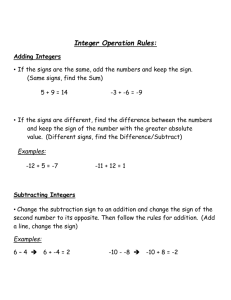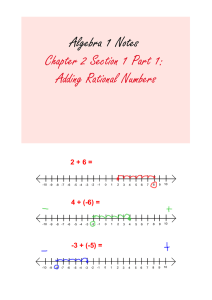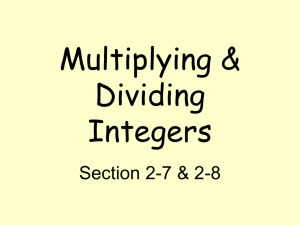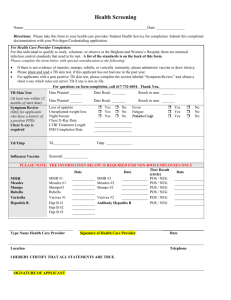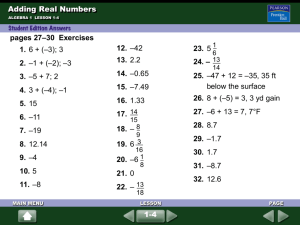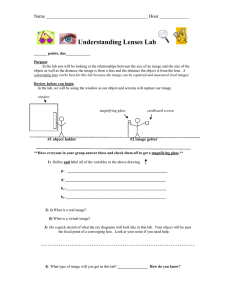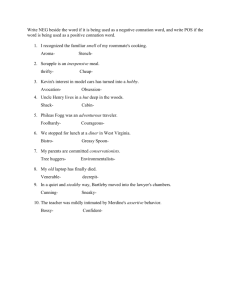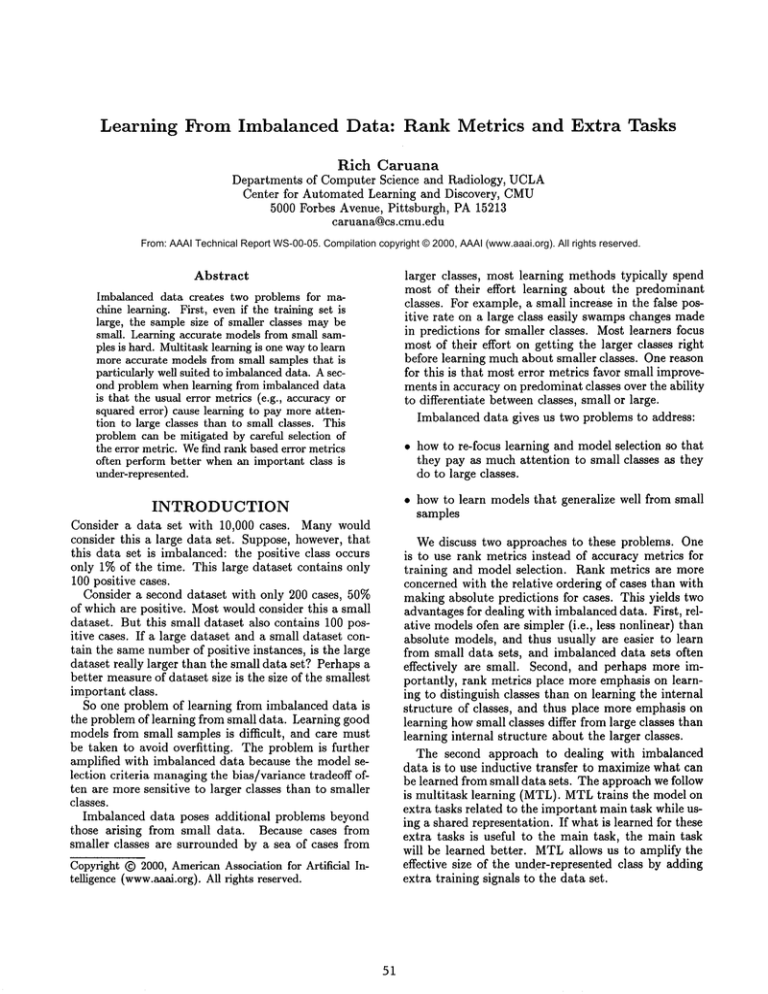
Learning
From Imbalanced
Data: Rank Metrics
and Extra Tasks
Rich Caruana
Departments of ComputerScience and Radiology, UCLA
Center for AutomatedLearning and Discovery, CMU
5000 Forbes Avenue, Pittsburgh, PA15213
caruana@cs.cmu.edu
From: AAAI Technical Report WS-00-05. Compilation copyright © 2000, AAAI (www.aaai.org). All rights reserved.
Abstract
Imbalanceddata creates two problemsfor machinelearning. First, evenif the training set is
large, the samplesize of smaller classes maybe
small. Learningaccurate modelsfromsmall samples is hard. Multitasklearningis onewayto learn
moreaccurate modelsfromsmall samplesthat is
particularlywellsuited to imbalanced
data. Asecond problemwhenlearning from imbalanceddata
is that the usual error metrics(e.g., accuracyor
squarederror) cause learning to pay moreattention to large classes than to smallclasses. This
problemcan be mitigated by careful selection of
the error metric. Wefind rank basederror metrics
often performbetter whenan importantclass is
under-represented.
larger classes, most learning methodstypically spend
most of their effort learning about the predominant
classes. For example,a small increase in the false positive rate on a large class easily swampschanges made
in predictions for smaller classes. Mostlearners focus
most of their effort on getting the larger classes right
before learning muchabout smaller classes. Onereason
for this is that most error metrics favor small improvementsin accuracyon predominatclasses over the ability
to differentiate betweenclasses, small or large.
Imbalanceddata gives us two problemsto address:
¯ howto re-focus learning and modelselection so that
they pay as muchattention to small classes as they
do to large classes.
¯ howto learn modelsthat generalize well from small
samples
INTRODUCTION
Consider a data set with 10,000 cases. Manywould
consider this a large data set. Suppose,however,that
this data set is imbalance&the positive class occurs
only 1%of the time. This large dataset contains only
100 positive cases.
Consider a second dataset with only 200 cases, 50%
of whichare positive. Mostwouldconsider this a small
dataset. But this small dataset also contains 100 positive cases. If a large dataset and a small dataset contain the samenumberof positive instances, is the large
dataset really larger than the small data set? Perhapsa
better measureof dataset size is the size of the smallest
important class.
So one problemof learning from imbalanceddata is
the problemof learning from small data. Learninggood
modelsfrom small samples is difficult, and care must
be taken to avoid overfitting. The problemis further
amplified with imbalanceddata because the model selection criteria managingthe bias/variance tradeoff often are moresensitive to larger classes than to smaller
Wediscuss two approaches to these problems. One
is to use rank metrics instead of accuracy metrics for
training and model selection. Rank metrics are more
concernedwith the relative ordering of cases than with
makingabsolute predictions for cases. This yields two
advantagesfor dealing with imbalanceddata. First, relative modelsofen are simpler(i.e., less nonlinear) than
absolute models, and thus usually are easier to learn
from small data sets, and imbalanceddata sets often
effectively are small. Second, and perhaps more importantly, rank metrics place more emphasison learning to distinguish classes than on learning the internal
structure of classes, and thus place moreemphasison
learning howsmall classes differ fromlarge classes than
learning internal structure about the larger classes.
The second approach to dealing with imbalanced
data is to use inductive transfer to maximizewhat can
be learned fromsmall data sets. Theapproachwe follow
is multitask learning (MTL).MTLtrains the model
extra tasks related to the importantmaintask while using a shared representation. If whatis learned for these
extra tasks is useful to the main task, the main task
will be learned better. MTLallows us to amplify the
effective size of the under-representedclass by adding
extra training signals to the data set.
classes.
Imbalanced data poses additional problems beyond
those arising from small data. Because cases from
smaller classes are surrounded by a sea of cases from
Copyright(~) 2000,American
Associationfor Artificial InteUigence(www.aaal.org).
All rights reserved.
51
RANK METRICS
the pos cases. Manymore will be moderately different
from the pos cases. And some of the neg cases will be
very similar to the pos cases. (Some neg cases may be
indistinguishable from pos cases, and vice-versa.)
Whenwe use an output encoding of 0/1 squared error, we force learning to treat all the neg cases the same
way. It is penalized for allowing someneg cases to have
predicted values near the value coding for pos cases.
This is not so serious a problem when the number of
pos and neg cases are balanced, because the penalty
is similar for pos cases with predicted values near the
value coding for neg cases. The two penalties roughly
balance each other as the net learns models that discriminate between the pos and neg cases.
But when the data is imbalanced, these two penalties
no longer balance each other. The net becomes far more
concerned about making the predictions for neg cases
be near the target value for neg cases (0) because there
are so many more neg cases than pos cases. It is far
less concerned about pos cases predicted to be the neg
target value. The real source of this problem is that
the net is not allowed to treat some neg cases differently from other neg cases - it needs to drive all kinds
of neg cases near the zero coding because there are so
manyneg cases, that even the small proportion of neg
cases that are similar to the pos cases will outnumber
the pos cases. The net spends more effort learning to
predict the same coded value for all neg cases than it
does learning to predict different values for pos and neg
Consider a data set with two classes, pos and neg. Suppose the data set has 10,000 instances, with 1/data set
suffers from data imbalance: it contains 9,900 neg instances but only 100 pos instances.
The Standard
Approach
Supposewe train an artifical neural net on this problem,
with an output coding of 0 for neg and 1 for pos. The
first thing the net learns is to adjust the bias weight on
the output unit so that it predicts values near zero for
all cases. The net predicts small values for all cases,
including the few pos cases in the training set.
This net has two qualitatively different directions
learning can go: it can learn to predict larger values
for pos cases, or it can learn to predict values closer to
zero for neg cases. Given that there are 100 times as
manyneg cases, a backprop net usually will learn more
about driving neg cases towards zero than driving pos
cases towards one. This disparity in what the net learns
about the two classes continues for a long time. Eventually, the net is so good at learning to drive neg cases to
values near zero that it places more emphasis on learning to drive pos cases to larger values. Unfortunately,
most of what the net learned to drive neg values near
zero probably is not relevant to distinguishing pos and
neg cases. Even worse, if the net can learn something
useful for the pos cases, but even slightly harmful to the
near-zero predictions for the neg cases, gradient descent
on squared error will not learn it. Things learned for
pos cases must not hurt neg cases.
One wayto avoid this is to artificially reduce the disparity between the sizes of the two classes by subsampling the larger class. But it is unfortunate to throw
away so much data. (A better approach would be to
subsample from the larger class manytimes, learn many
models, and combine those models by averaging.) Another way to avoid this problemis to increase the weight
applied to errors on the less frequent pos cases. This
forces learning to pay more attention to errors on the
pos cases early in learning. This is a good approach.
Unfortunately, it has a problem: if the number of pos
cases is small (e.g., only 100 pos cases), learning almost certainly will overfit the pos cases as it tries to
learn models that makes small errors on these few, but
highly weighted, cases.
Benevolent
cases.
One solution to this problem is to introduce intermediate codings for some neg cases that allow neg cases
similar to pos cases to have target values closer to the
target values for pos cases. Ideally, some benevolent
spirit would take all the neg cases, and label them with
values between 0 and 0.99 indicating how similar they
are to the pos cases, which are still labelled as 1.0.
Given this benevolent relabelling, manyof the problems
of learning from imbalanced data go away. Of course
the real world rarely is this benevolent. Rank metrics,
however, allow us to create intermediate valuations for
the neg cases. Andas a bonus, the models that have to
be learned typically are simpler (i.e., less non-linear),
and thus are easier to learn from small data sets.
Benevolent
Ranks: Rankprop
Several years ago we introduced a method called
rankpropthat learns to predict the target values for the
neg cases at the same time it learns a modelto discriminate bwetween the pos and neg cases (Caruana, Baluja
and Mitchell 1994). Rankprop uses a rank metric instead of the absolute 0/1-based metric above. The basic
approach in rankprop is as follows: rank the training set
by the true class, neg and pos. This ranks all neg cases
below all pos cases. Assign to each training case a target value between 0 and 1 based on its position in this
ranking. (Note that because all neg cases get the same
rank, they all get assigned a value of 0.495. Similarly,
the pos cases all get assigned 0.995.)
Spirits
Can we force learning to pay similar attention to both
classes at all stages of learning without provoking massive overfiting to the smaller class? Often we can. The
real source of the problem is that we used an output
coding of 0 for neg cases and 1 for pos cases. Moreover,
we trained the net using squared error. This is very
unfortunate output coding and error metric for imbalanced data.
Most real-world problems exhibit a range of neg
casts. Manyof the neg cases will be very different from
52
Train the backprop net on these target values for one
epoch. So far there is little to distinguish rankprop from
training on 0/1 targets except that the targets are not
0 and 1 (which isn’t significant). Here’s where a difference arises: After performing one epoch of backprop,
re-rank the training cases using the net’s predictions
as secondary keys in the ranking. All neg cases are
still ranked below all pos cases (the class is the primary key), but the predictions for each case allow ties
between neg cases to be split (and similarly for ties between pos cases, but this is less important since their
values will always fall between 0.99 and 1.0). Using this
new ranking, re-assign the target values for the training cases. Nowsome neg cases have target values near
0.0, and others have target values near 0.99. Using the
new target values, perform a second epoch of backprop.
After this epoch, once again use the net’s predictions
to re-rank the pos and neg cases, and assign new target
values to the training cases based on the new rankings.
Do another epoch. Repeat.
Rankprop allows neg cases to acquire target values
that place them nearer or farther from the few pos cases.
In fact, almost 50%of the neg cases will have target values above 0.5! Moreover, there is no pressure for the
net to assign any particular value to any particular neg
case. The net is allowed to discover an ordering of the
neg cases that is most compatible with the discrimination modelit is trying to learn to distinguish beteen the
pos and neg cases. This means that the rankprop net
is not driven to spend most of its effort driving the neg
cases towards an unrealistic target value of zero, eliminating the pressure caused by imbalanced data that
had caused the net to learn more about neg cases than
about pos cases.
A second benefit of this approach is that for many
problems, the target values that correspond to the
ranked data form a smoother function than the 0/1
targets. Since it is easier to learn smoother, less nonlinear functions from limited data, rankprop models often overfit the pos samples less. The combination of
these two effects can yield dramatic improvements. For
example, on a medical problem where training sets contained 1000 cases, and where the pos class occurred only
10/performance. (Much of this benefit would disappear
if the data sets were very large, and if the data were balanced.)
Soft Ranks
Rankprop is a complex method that learns soft target
values for the neg cases while it is learning a modelto
discriminate between the pos and neg cases. Manyerror
metrics based on rankings (instead of absolute target
values) confer similar advantages when learning ~from
imbalanced data, even if they don’t explicitly train on
iteratively reassigned target values. For example, if you
learn to optimize the ROCarea for imbalanced data,
the imbalance problems that rankprop sidesteps also
will be sidestepped. Wetake advantage of this observation to introduce a more general rank-based learning
procedure.
Rankpropis effective, but it is not clear howto adapt
Rankprop to learning algorithms other than backprop.
We developed a new ranking mathod called Soft Ranks
that is more flexible than rankprop and can be adapted
for most learning methods. More importantly, soft
ranks allow us to use any rank metric as an error metric
for learning.
Ranking takes continuous data and converts it to a
discrete ordering. Small changes in the predicted value
of a case usually do not affect the ranking unless they
are large enough to cause that case to be ranked to a
different palce. This makes it difficult to use metrics
defined on ranks with learning methods such as gradient descent: the large number of plateaus in the error
surface cripples gradient descent. For example, if the
predicted value of B changes from 0.13 to 0.14 in the
data set shownbelow, it still ranks 2nd in the set.
ITEMS
TRADITIONALRANKS
A:
B:
C:
D:
E:
0.25
0.13
0.54
0.27
0.08
=>
E:
B:
A:
D:
C:
0.08
0.13
0.25
0.27
0.54
->
->
->
->
->
1
2
3
4
S
Soft Ranks is a generalization of standard discrete
ranks that gives ranks a continuous flavor, making it
easier to create differentiable error metrics based on
ranks. The main problem solved by soft ranks is to
make small changes to the predicted value of a case
have a small affect on the ranking of that case. This
eliminates the plateaus that can hinder learning. A
small modification to the traditional rank procedure
eliminates the plateau problem while preserving rank
semantics. Order the data as usual and temporarily
assign to each item the traditional rank. Then, postprocess the traditional ranks as follows:
SR(i) = TR(Prev(i))
V(i) - V(Prev(i))
0. 5 + V(Post(i) - V(Prev(i))
whereTR(i) is the traditional rank ofi, SR(i) is its continuous rank, V(i) is i’s value, and Prev(i) and Post(i)
denote the items that rank just before and just after i,
respectively.
TRADITIONALRANKS
E:
B:
A:
D:
C:
0.08 ->
0.13->
0.25 ->
0.27 ->
0.54 ->
1
2
3
4
5
=>
SOFT RANKS
E:
B:
A:
D:
C:
0.08 -> i -> 1
0.13-> 2-> 2.088
0.25 -> 3 -> 3. 300
0.27 -> 4 -> 3. 569
0.54 -> 5 -> 5
Item A’s value is closer to item D’s value than to item
B’s value. The soft rank reflects this by assigning to
A a soft rank closer to the soft rank of D than to the
soft rank of B. Moreover,if changesin the values cause
neighborsto swap, the soft ranks reflect this in a smooth
way.
53
Qualitatively, soft ranks behave like traditional
ranks, but are continuous: small changes to item values yields smallchangesin the soft ranks. It is possible
to use soft ranks in mosterror metrics that use traditional ranks. Mosterror metrics defined on soft ranks
are similar to those defined on traditional ranks, except
that soft ranks will not makethe error metric discontinuous like traditional. This meansit is easier to apply
gradient descent to error metrics based on soft ranks.
Asweshall see in the next section on multitasklearning, soft ranks allow rank-basederror metrics to be optimized using gradient descent for learning.
weightfor each feature dimensionthat controls howimportant that dimensionis to the distance computation.
In simple unweightedEuclideandistance, Vi, Wi= 1.0.
Kernel Regression
Kernel regression (also knownas locally weightedaveraging) uses the distance metric to weightthe contribution of each training case to the prediction:
PRED
= ~’-]~i~l VALi-DIST(ci’ct¢’t)/KW
* e
~iN=le-D’sr(~,,~,o.,)/KW
where N is the number of cases in the case base,
DIST(ci, Chew)is the distance betweencase ci and the
test (probe) case, and KWis the kernel width that determines the scale of the neighborhoodthat has most
effect. See (Atkeson, Mooreand Schaal 1997) for more
detail about locally weightedaveraging.
FOCUSSING
LEARNING
WITH
EXTRA TASKS
Multitask Learning (MTL)is an inductive transfer
method that uses the information contained in the
training signals of related tasks to improvethe generalization performanceof the maintask. It does this by
learning the extra tasks in parallel with the maintask
while using a shared representation - what is learned
for the extra tasks can help the main task be learned
better. In artificial neural nets, multitask learning is
done b~ training all the tasks on one neural net using a single hidden layer shared by the tasks. The
shared hidden units allow someof the features learned
for the extra tasks to be used by the outputs for the
main task.(Abu-Mostafa 1989)(Suddarth and Holden
1991) (Caruana 1993)(Baxter 1994)
MTLhelps learning from imbalanced data in two
ways:
1. Because MTLimproves generalization performance
whenlearning from small data sets, and imbalanced
data sets effectively often are small data sets, MTL
makeslearning from them moreeffective.
2. The extra tasks used in MTLcan be used to focus
the learner’s attention towardsthe under-represented
classes.
MTLis equally effective with case-based methods
such as kernel regression and k-nearest neighbor. Since
these methodsdo not have a hidden layer to share between tasks, we use an error metric that combinesthe
performanceon the main task with the performanceof
the extra tasks. This causes modelsto be learned that
performwell on both the maintask and the extra tasks.
Feature Weights and the Distance Metric
The performanceof case-based methodslike kernel regression dependson the quality of the distance metric.
Findinggoodfeature weightsis essential to optimalperformance. The search for good feature weights can be
cast as an optimization problem. Gradient descent is
used with leave-one-out cross validation (CV)to search
for goodfeature weights. Feature weightsare initialized
to a starting value such as 1.0, and the CVperformance
of the initial weightsis calculated. Thegradient of the
CVperformancewith respect to the feature weights is
calculated, and a step is taken downthe gradient. If the
updated feature weights improve performance as measured by CV,the step is accepted. If not, the step is
rejected and the step size is reduced. This process is
repeated until a local minimum
in CVperformance is
found.
Unfortunately,if this processis applied to imbalanced
data using 0/1 codings and a squared error (or accuracy) error metric, the same problem arises as when
backpropnets were trained this way: gradient descent
spends moretime learning feature weights that are good
at pushing neg cases towards their target coding than
at learning weights that distinguish between pos and
neg cases. Instead of rankprop(which isn’t applicable
to case-based methods), weuse the soft ranks to force
learning to pay more equal attention to the pos and
neg cases. Wealso use extra tasks to force learning to
learn modelsthat pay more attention to the less frequent class.
Weighted Euclidean Distance
The distance metric most commonlyused for kernal
regression and k-nearest neighbor is weightedEuclidean
distance:
Multitask Learning in Kernel Regression
Thegoal is to find feature weightsthat yield goodperformance on both the main task and on the related
extra tasks. Wedo this by using an error metric that
combines the performance on the main task with the
performanceon the extra tasks. This causes gradient
descent to learn feature weights that perform well on
both the main task and the extra tasks. If the extra
tasks are selected to help the modelbetter learn distinctions betweenthe imbalancedclasses, it will help focus
!
DIsr(cx,
c2)= 41w,, - r,,o2)2
i=1
wherecl and c2 are two cases, D is the numberof feature dimensions,Fi,c is feature i for case c, andWi is a
54
the model on characteristics of the under-represented
classes.
Weweight the contribution of the extra task performances because it is possible for many extra tasks to
swampthe error signal of the main task if the extra
tasks are too dissimilar. The contribution of the extra
tasks to the combined error metric is controlled by a
single weight ~:
between patients of different risk, even if the aditional
risk did not cause the patient to die. Because high risk
is more commonthan death, the extra tasks mitigate
some of the problems of imbalanced data by creating
extra tasks that are less imbalanced, but related to the
main task that unfortunately is imbalanced.
TASKS
MTL_ERF ---
(1-
~)MAIN_ERF + )t
~ ERR(t)
t=l
where MTL_ERFis the multitask learning criterion
being minimizedby gradient descent on feature weights,
MAIN_ERRis the performance on the main task,
ERR(t) is the performance on extra task t, and )~ is
defined on [0.0, 1.0]. When)~ = 0, all weight is given
to the main task and the extra tasks are ignored. This
is traditional learning of a single task. When$ = 0.5,
equal weight is given to the main task and to each extra task. When$ = 1.0, all weight is given to the extra
tasks and the main task is ignored.
Pneumonia Risk Prediction
Here we apply MTLto a pneumonia problem that has
imbalanced data. The goal is to predict which patients
have the least risk of dying from pneumonia (all patients have already been diagnosed with pneumonia).
Approximately 11%of the hospitalized patients in the
database died of pneumonia. The measurements available for most patients include 30 basic measurements
acquired prior to hospitalization such as age, pulse,
blood pressure, and 33 lab tests such as blood counts or
gases usually will not available until after hospitalization. The database also indicates whether each patient
lived or died.
The most useful medical tests for predicting pneumonia risk usually require hospitalization. But we’d like
to predict risk before patients are hospitalized so that
those at low risk can be considered for outpatient care.
Before hospitalization, we have available just 30 basic
measurements such as age, gender, and blood pressure.
Because all patients in our database were hospitalized,
however, we also have in the database the results of the
33 lab tests that usually are only available for hospitalized patients. Wecan use these extra tests to help
mitigate some fo the effects of imbalanced data. Although the lab test results will not be available when
the model is used (before patients are admitted), multitask learning can be used to improve performance on
the main task by using the extra lab test results available in the training set.
Learning these extra tests help mitigate the imbalanced data problem by forcing learning to learn more
complete models. Someof these tasks are particularly
useful because they are designed to present normal values for most well patients, and to show more unusual
values for moreseriously ill patients. By learning to predict these results, the modelhas to learn to differntiate
55
Loss Functions
The main prediction task is mortality risk. Kernel regression predicts mortality risk by examining whether
the close neighbors in the case-base to the new probe
case lived or died. The optimization error metric we
adopt for this task is the sum of the soft ranks for all
patients in the sample who live. Successfully ordering
all patients wholive before all patients who die minimizes this sum. Wescale the sum of soft ranks so that
0 indicates this ideal performance. Randomordering of
the patients yields soft rank sums around 0.5.
The extra tasks include predicting the white blood
cell count, hematocrit, albumin level, or partial pressure of oxygen in the blood. The error metric we use
for the extra tasks is the standard sum-of-squares loss.
Predictions for the extra tasks are not used to predict
patient risk. Learning to minimize the sum-of-squares
error of the extra tasks is useful only if it helps the
model learn feature weights that improve performance
on the main risk task.
Empirical Results
Feature weights for the 30 input features are initialized
to 1.0. Gradient descent with line searches is done using CVon the training set. Weuse KW= 1.0, a value
preliminary experiments indicate performs well on this
problem. The value KWis not trained via gradient descent because training the feature weights can provide
a similar effect.
The original dataset is randomly subsampled to create training, halt, and test sets. Becausethe search for
feature weights repeatedly uses the same training set,
overtraining is likely. A halt set is used to prevent this.
Because halt set performance is often not monotonic,
premature early stopping can be a problem. To prevent this, gradient descent is run for a large number
of steps, and the feature weights yielding best performanceon the halt set is found by examining the entire
training curve. The weights learned at this point are
then tested on the independent test set.
This first experiment examines how much attention
learning should pay to the extra tasks. Is it better to
ignore the extra tasks and optimize performance only
on the main task, or is better performance on the main
task achieved by optimizing performance on all tasks?
Figure 1 shows the mean rank sum error of 50 trials
of learning as a function of )t for training and halt sets
containing 500 patterns each. Each data point has error bars indicating the standard errors. The horizontal
line at the top of the graph is the performance of kernel regression when all feature weights are 1.0, before
any training has been done. Because no learning has
0.061
0.06
i
i
i
i
!
|
i
lal.....................................................................
~.....................................................................=a
0.059
0.055
0.057
W
0.056
0.055
0
0.2
0.4
0.6
0.8
Weight of Extra Tasks Compared with Main Task
1
Figure 1: Rank SumError as a Function of )~
occurred, and because performance is measured only
on the main mortality risk prediction task, this performance is independent of ,~ and thus forms a horizontal
line on the graph.
How Much Does MTL Help?
Multitask kernel regression outperforms traditional single task kernel regression about 5% on this domain
when trained with 1000 cases (500 train plus 500 halt).
Howmany more training examples would be needed to
yield this much improvement without multitask learning? Weran experiments using training sets containing
200, 400, 800, 1600, and 3200 training patterns, using
single task learning (A = 0.0) and multitask learning
with A = 0.5.
The curve in Figure I below the horizontal line shows
howvarying )~ affects performance on the main risk prediction task. As expected, training feature weights with
gradient descent improves performance. The point at
)~ = 0 is the performance of learning with traditional
single task learning; the extra tasks are completely ignored by gradient descent when ,~ = 0. Training the
feature weights on the single main risk task reduces
rank sum error about 2.5% compared with weights initialized to 1.0 and not trained.
0.075
i
~
i
i
i
i
*STL--lambda=0.0"
"MTL--lambda-0.5"
-+--.
0.07
The points for )~ > 0 are multitask learning. Larger
values of A give more weight to the extra tasks, z From
the graph it is clear that learning yields better performanceon the main task if it searches for feature weights
that are good for both the main task and for the extra
tasks. Note that multitask learning is not using any extra training patterns, it just has more training signals
in each pattern. Multitask learning is training and testing on the same training patterns used to train feature
weights on the main task by itself.
~
0.065 ~
0.06
LU
E
0.055
n-
0,05
TotalPatterns
Used
forTraining
(Train+Halt)
Figure 2: Rank Sum Error of STL ()~ = 0) and
(~ = 0.5) vs. Training+Halt Set Size
The optimal value of A is between 0.2-0.8. Interestingly, these )~s place near equal weight on the main task
and on each extra task. At )~ = 0.5 all tasks - including
the main task- are given equal weight. At A ~, 0.5,
multitask learning reduces error about 5-10%.
Figure 2 shows the performance of 25 trials of single
task kernel regression ()~ = 0) and multitask kernel
gression with )~ = 0.5 as a function of training set size.
Between 200 and 1000 cases, the improvement due to
multitask learning is equivalent to a 50-100%increase
in the numberof training patterns. The benefit of multitask learning, however, decreases when the sample size
is large. With training sets larger than 3200, the performance with A = 0.5 may be worse than with ~ = 0.
The extra tasks are not helpful if the sample size is large
enough to insure excellent performance from optimizing
the main task alone. 0 < ~ < 0.5 however, may yield
1The vertical axis shows performance on only the main
risk prediction task. The contribution of the extra tasks
to the error metric is not shown- thoughits effect on the
error for the main task is apparent. In this problem we
are not concerned with howaccurately the extra tasks are
predicted. The reason for including the extra tasks is so
that they will help better feature weights be learned and
thus improve performance on the main task.
56
MedisGroups Comparative Hospital Database,"
ican Journal of Medicine, 94 1993.
better performance than single task learning (A = O)
even with training sets this large.
Amer-
Pratt, L. Y., Mostow, J. & Kamm,C. A. (1991) Direct
Transfer of Learned Information AmongNeural Networks. Proceedings of AAAI-91.
SUMMARY
Imbalanced data creates several problems for machine
learning. One problem is that imbalanced data sets often act is if they are small data sets because someclasses
often have few cases. The second problem is that learning often places more emphasis on learning about the
predominant classes than about learning to distinguish
between large and small classes. This paper discussed
two approaches to these problems. One of these is to use
rank metrics such as rankprop or soft ranks to prevent
learning from placing too muchfocus on learning about
the larger classes at the expense of learning to differntiate all classes, both large and small. The other is to
use extra tasks that are related to the class distinctions
that must be learned, but which suffer from less imbalance. This multitask learning approach focuses learning
towards more complete models that better capture features related to important inter-class distinctions. We
combine both of these methods (soft ranks and MTL)
and test them on a pneumonia risk prediction problem
that has imbalanced data. Earlier results (not included
in this paper), show that rank methods improve performance over the standard non-rank methods 30-50% on
this problem. MTLimproves this performance an additional 5-10%. Someof the problems of learning from
imbalanced data can be mitigated by careful choice of
error metric and by forcing learning to learn more complete models.
S. C. Suddarth and A. D. C. Holden, "Symbolic-neural
Systems and the Use of Hints for Developing Complex
Systems," International Journal of Man-MachineStudies 35:3, pp. 291-311, 1991.
S. Thrun and T. Mitchell, "Learning One More Thing,"
CMUTR: CS-94-184, 1994.
I
References
Y. Abu-Mostafa, "Learning From Hints in Neural Networks," Journal of Complexity 6:2, pp. 192-198, 1989.
C. Atkeson, A. Moore, and S. Schaal, "Locally
WeightedLearning," Artificial Intelligence Review, (in
press).
Baxter, J., "Learning Internal Representations", Ph.D.
Thesis, The Flinders Univeristy of South Australia,
Dec. 1994.
R. Caruana, "Multitask Learning: A Knowledge-Based
Source of Inductive Bias," Proceedings of the lOth International Conference on Machine Learning, pp. 41-48,
1993.
R. Caruana, "Using the Future to "Sort Out" the
Present: Rankprop and Multitask Learning for Medical Risk Prediction," Advances in Neural Information
Processing Systems 8, 1996.
G. Cooper, et al., "An Evaluation of Machine Learning
Methods for Predicting Pneumonia Mortality," AI in
Medicine, 1997.
M. Fine, D. Singer, B. Hanusa, J. Lave, and W. Kapoor,
"Validation of a PneumoniaPrognostic Index Using the
57


